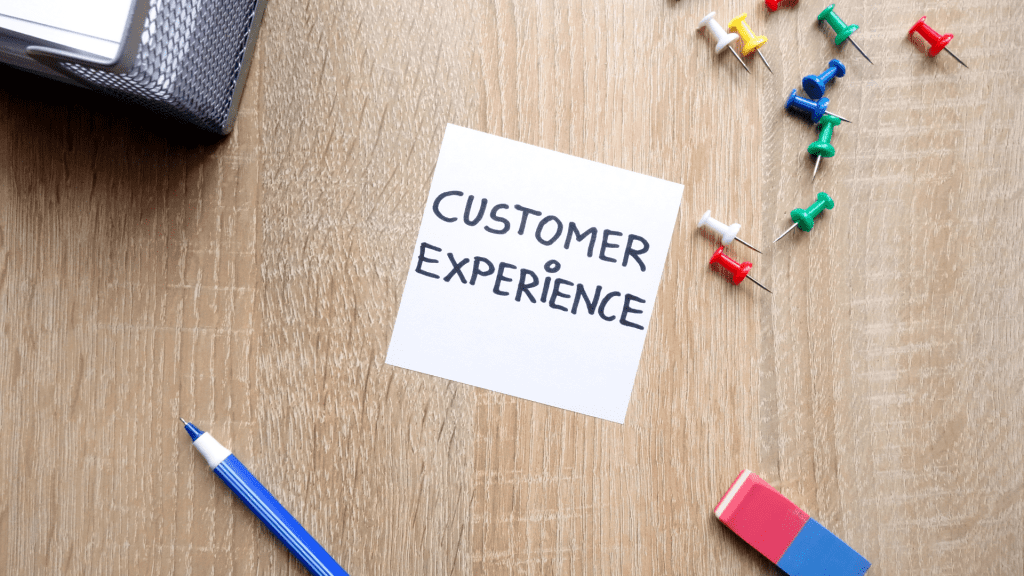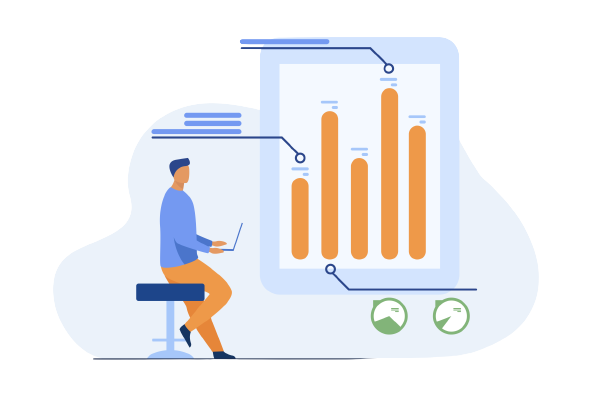

Learn how to craft a winning customer experience strategy with our comprehensive guide. Discover best practices, real-life success stories, and key metrics to measure your CX initiatives.



Remember the days when brand loyalty was simply a matter of having a good product? Those days are a thing of the past. With countless options readily available, customers crave memorable experiences that go beyond the initial purchase. You must have a Customer Experience Strategy to remain competitive because this is where you will win (or lose) customers.



In this article we are going to discuss:
Customer experience encompasses every interaction a customer has with your brand, from the first contact to post-purchase support. It’s the sum of all touchpoints across the customer journey. A positive customer experience can turn customers into loyal advocates, while a negative one can drive them straight to your competitors.
Think back to a recent customer experience you had. Did you feel valued and understood throughout the process, or did frustration and disappointment leave a lingering negative impression? Chances are, you remember both scenarios vividly.
A robust CX strategy is essential for several reasons:
Happy customers are more likely to stick around. According to a study by Bain & Company, increasing customer retention rates by 5% can increase profits by 25% to 95%.
Not just that, happy customers become your biggest advocates, raving about your brand online and offline, driving organic growth and propelling you ahead of the competition.
Retention is the Single Most Important Thing For Growth
Facebook VP of Growth - Alex Schultz
Satisfied customers spend more and are less price-sensitive. Research by Temkin Group found that companies earning $1 billion annually can expect to earn, on average, an additional $700 million within three years of investing in customer experience.
Great experiences turn customers into brand advocates. Loyal customers are five times more likely to purchase again and four times more likely to refer a friend.
Superior CX can differentiate you from competitors. A positive CX fosters trust and loyalty, leading to a better overall reputation that attracts new customers.
89% of companies now expect to compete mostly on the basis of customer experience.
Gartner
You’ve learned why CX matters and the importance of a winning strategy. Now, let’s delve deeper into crafting an exceptional customer experience. Here is how you can start:
Gather data to understand your customers’ needs, preferences, and pain points. Collect insights by using surveys, feedback forms, and voice of customer tools. Creating detailed customer personas can help you visualize your typical customers and tailor experiences to their specific needs.
For example, a B2B software company might create personas such as “Tech-Savvy Tina” or “Budget-Conscious Bob” to better understand and address the distinct needs of their user base.
Create a customer journey map to visualize every touchpoint a customer has with your brand. Identify key stages such as awareness, consideration, purchase, and post-purchase. This map will help you spot areas where you can enhance the customer experience. For instance, a retail company might discover through journey mapping that customers often abandon their online shopping carts due to complicated checkout processes. Streamlining this process could significantly improve the customer experience.
Define what you want to achieve with your CX strategy. Objectives might include improving customer satisfaction scores, increasing repeat purchases, or boosting net promoter scores (NPS). Clear goals will guide your efforts and provide a benchmark for measuring success. For example, if your goal is to increase NPS by 10 points over the next year, you can measure progress through regular customer surveys and adjust your strategy accordingly.
Your employees are the frontline of your CX strategy. Provide them with the tools, training, and authority to deliver exceptional service. Encourage a customer-centric culture where every team member understands their role in creating positive customer experiences. Zappos, known for its stellar customer service, empowers its employees to go above and beyond, even authorizing them to spend extra time and resources to make a customer happy.
Use data to personalize interactions at every touchpoint. Whether it’s personalized email campaigns, product recommendations, or tailored customer support, personalization shows customers that you value them as individuals. Amazon, for instance, uses browsing and purchase history to recommend products that are likely to interest each customer, enhancing their shopping experience and increasing sales.
Regularly seek feedback from customers and use it to refine your CX strategy. Implement systems to track and analyze feedback, and ensure you act on the insights you gather. This continuous improvement loop is crucial for maintaining high CX standards. For example, Starbucks uses its “My Starbucks Idea” platform to collect customer feedback and suggestions, which has led to numerous successful innovations, including new flavors and mobile payment options.
Measuring the success of your customer experience initiatives is crucial to understanding their impact and making informed decisions for improvement. Here are some key metrics and methods to effectively measure your CX efforts:
NPS is a widely used metric that measures customer loyalty by asking one simple question: “On a scale of 0 to 10, how likely are you to recommend our company to a friend or colleague?” Customers are then classified as Promoters (9-10), Passives (7-8), or Detractors (0-6). The NPS is calculated by subtracting the percentage of Detractors from the percentage of Promoters. A high NPS indicates strong customer loyalty and satisfaction.
CSAT measures customer satisfaction with a specific interaction, product, or service. Typically, customers are asked to rate their satisfaction on a scale of 1 to 5. This metric provides immediate feedback on customer interactions and helps identify areas for improvement. For example, after a customer support call, you might ask, “How satisfied were you with the assistance you received today?”
CES measures how easy it is for customers to interact with your company and resolve issues. It asks customers to rate the ease of their experience on a scale from “very difficult” to “very easy.” A lower effort score often correlates with higher customer loyalty, as customers prefer interactions that require minimal effort.
Churn rate is the percentage of customers who stop doing business with you over a given period. Monitoring your churn rate helps identify if there are issues in your customer experience that are causing customers to leave. High churn rates indicate dissatisfaction and highlight the need for immediate action.
CLV measures the total revenue a business can expect from a single customer over their entire relationship. Increasing CLV is often a sign of a successful CX strategy, as it indicates that customers are not only staying longer but also spending more. This metric helps prioritize initiatives that enhance long-term customer relationships.
Direct customer feedback through surveys, reviews, and social media provides qualitative data that offers insights into customer perceptions and experiences. Regularly analyze this feedback to identify common themes and areas for improvement. Implementing feedback loops ensures that customer voices are heard and acted upon.
This metric measures the average time it takes to resolve customer issues. Shorter resolution times typically lead to higher customer satisfaction. Monitoring this metric helps ensure that your support team is efficient and responsive.
When it comes to customer experience (CX) success stories, few companies are as celebrated as Zappos. This online shoe and clothing retailer has built its brand and reputation on delivering exceptional customer service.
At the heart of Zappos’ CX success is its core philosophy: “Deliver WOW through service.” This commitment to outstanding service permeates every aspect of the company, from its hiring practices to its customer interactions. Here are some key components of Zappos’ approach to customer experience
Zappos fosters a customer-centric culture where employees are empowered to prioritize customer satisfaction above all else. This culture is ingrained from day one, with all new hires, regardless of their role, spending their first few weeks working in the call center to understand the importance of customer service.
One of the most famous examples of Zappos’ dedication to customer service is the story of a customer service representative who spent over 10 hours on a single call. The representative patiently helped a customer with their shopping needs while engaging in a friendly conversation. This level of dedication not only resolved the customer’s issue but also left a lasting impression, turning the customer into a lifelong advocate for the brand.
Zappos empowers its employees to make decisions that benefit the customer, even if it means going beyond standard protocols. For example, Zappos’ customer service representatives are given the autonomy to resolve issues without needing to consult a manager. They can authorize refunds, offer free shipping upgrades, and even send flowers to customers going through a tough time.
Personalization is a cornerstone of Zappos’ customer experience. Employees are encouraged to develop genuine connections with customers. There are numerous stories of Zappos representatives spending hours on the phone with customers, not just discussing orders, but also building rapport and showing genuine interest in their lives.
Zappos’ hassle-free return policy is legendary. Customers can return items up to 365 days after purchase, with no questions asked. This policy removes the fear of making a wrong purchase decision and enhances customer trust.
Zappos goes the extra mile to surprise and delight its customers. Instances of unexpected upgrades to overnight shipping, handwritten thank-you notes, and small gifts in packages are common. These thoughtful touches create memorable experiences that keep customers coming back.
Zappos actively seeks and acts on customer feedback. They use insights from customer interactions to continuously improve their service. For example, if multiple customers mention issues with a particular product, Zappos takes immediate action to address the problem, whether it’s through product improvement or better customer communication.
Building a winning CX strategy isn’t just about keeping customers happy – it’s about creating loyal brand advocates who drive growth and success. By prioritizing customer needs, fostering meaningful connections, and continuously refining your approach, you can transform the customer experience into a powerful competitive advantage. Remember, in today’s experience-driven economy, happy customers are your most valuable asset. Invest in CX, and watch your business thrive.
Don’t forget to share this post






Don’t Let Your Competitors Understand Your Customers Better Than You
Don’t miss out. Try our 30-day Free Professional Trial.

